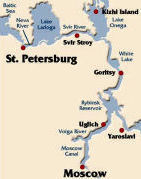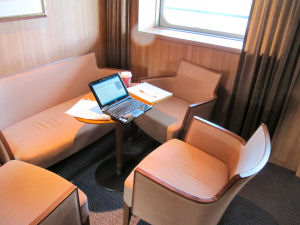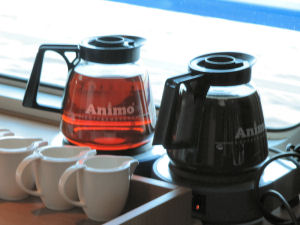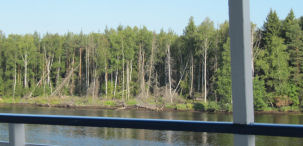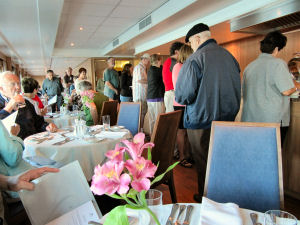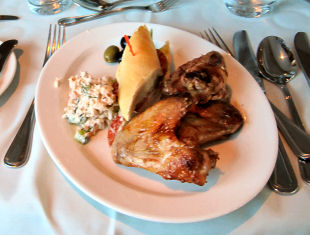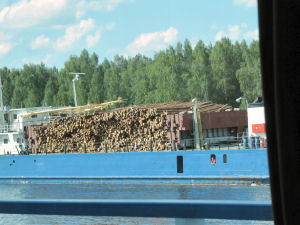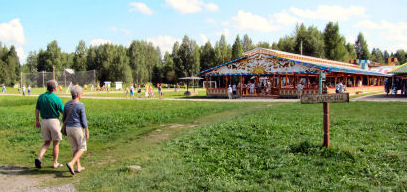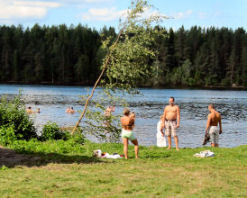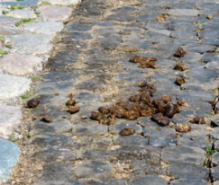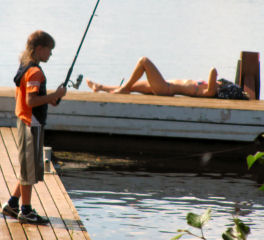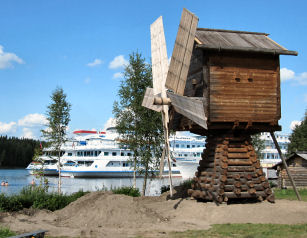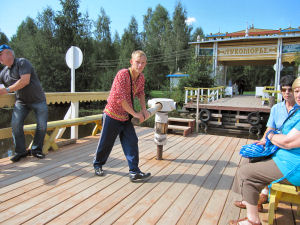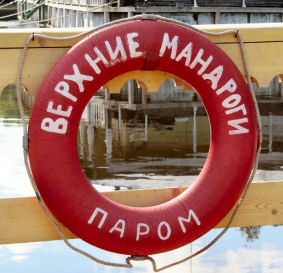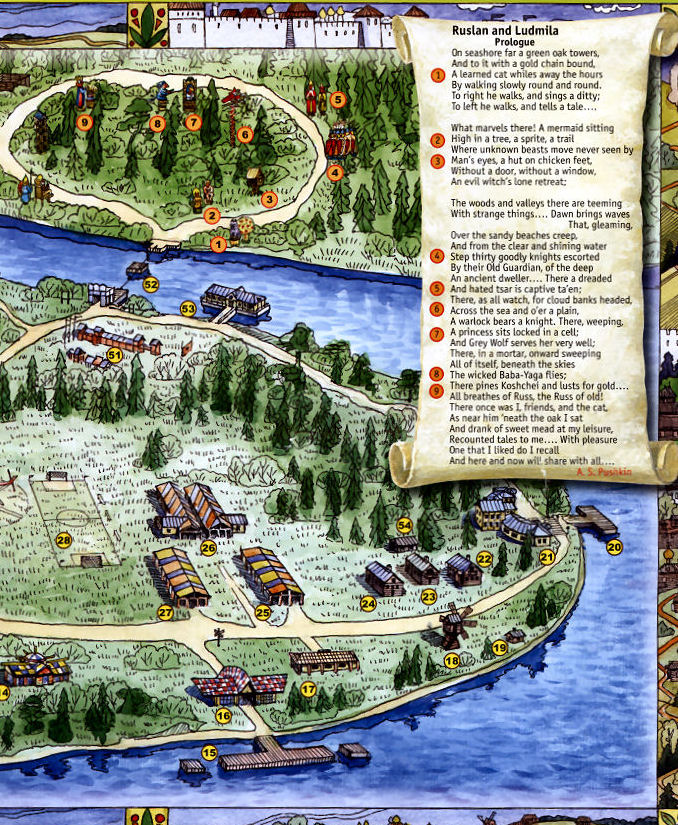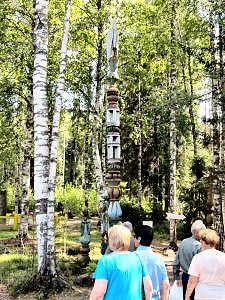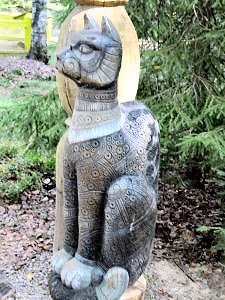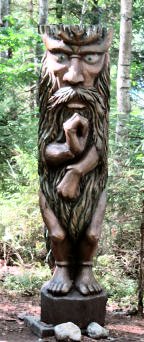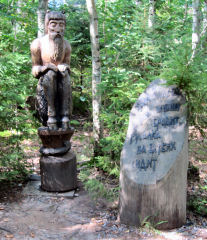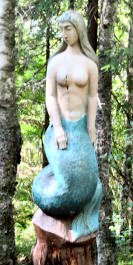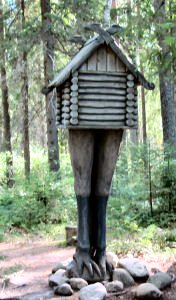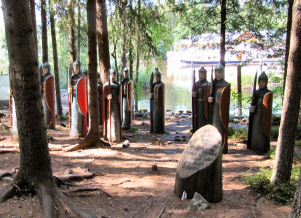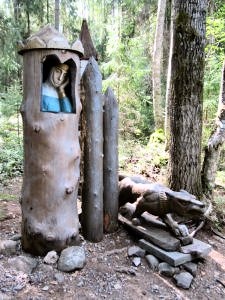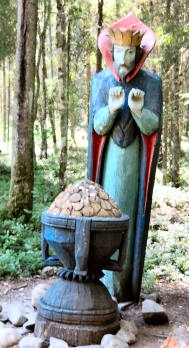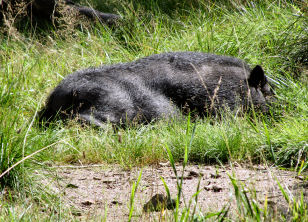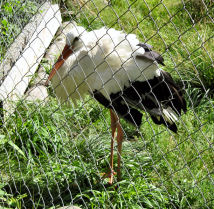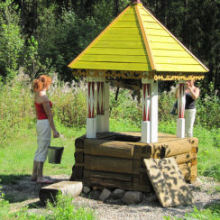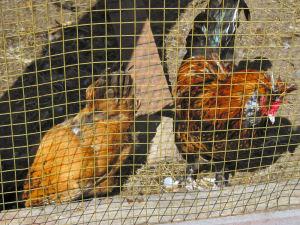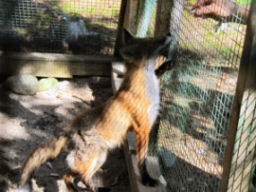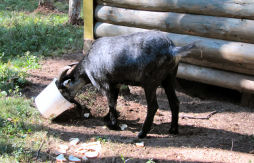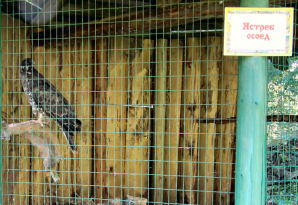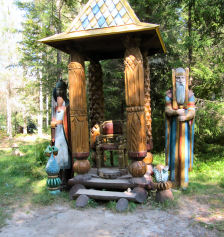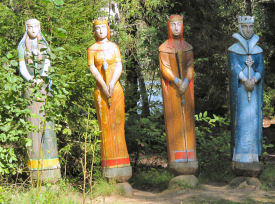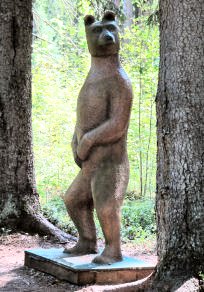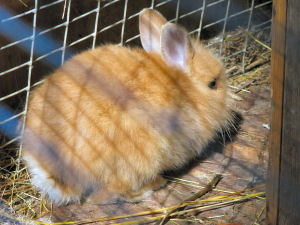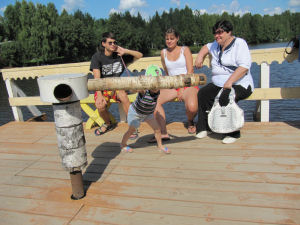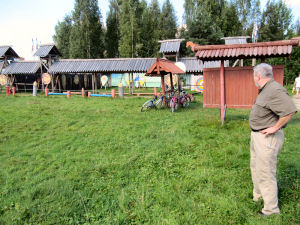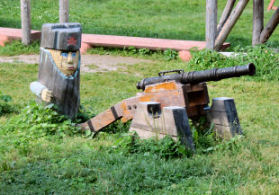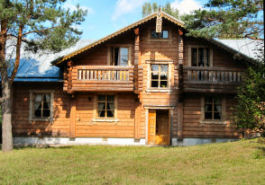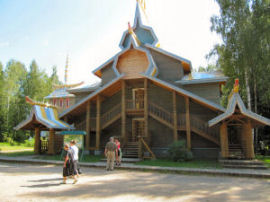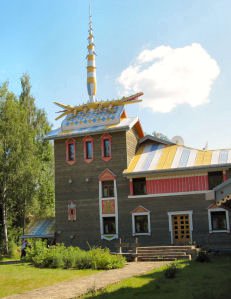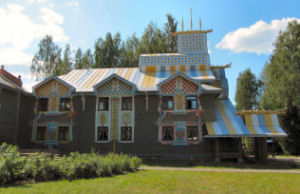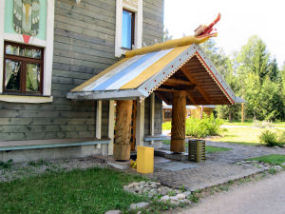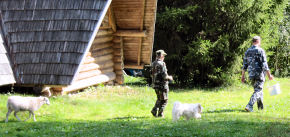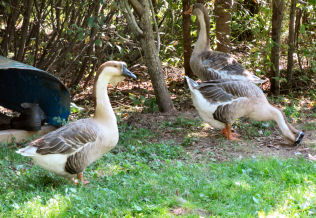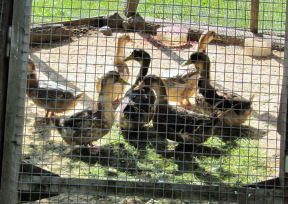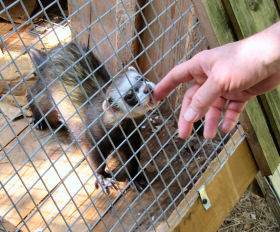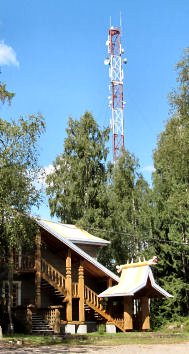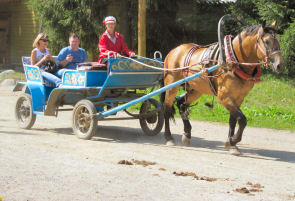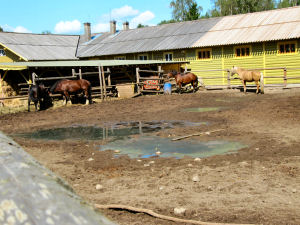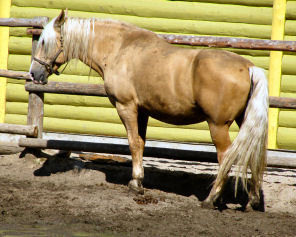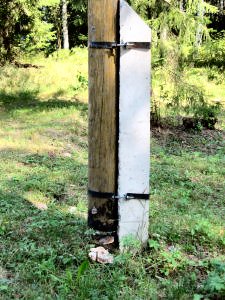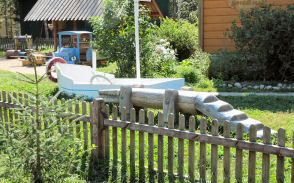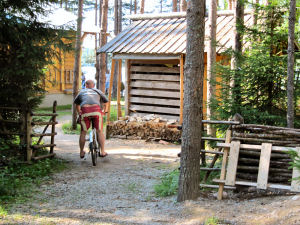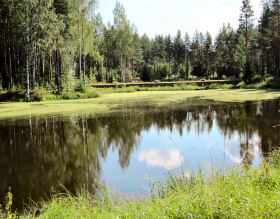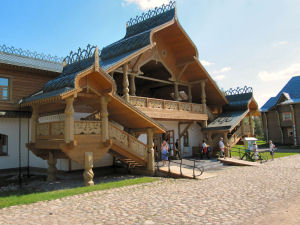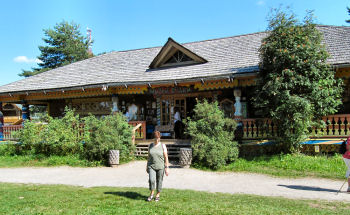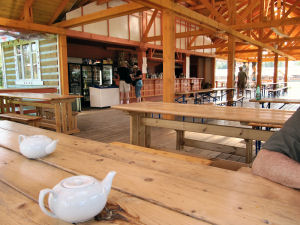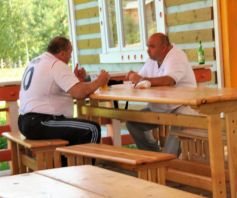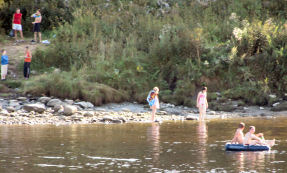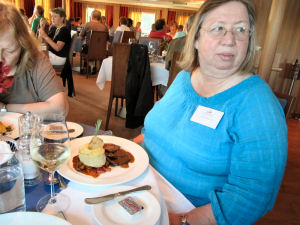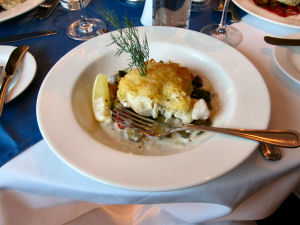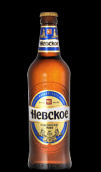The only thing on the schedule for this Friday the thirteenth was the outing to Mandrogi in the afternoon. I imagined that most of the rest of the passengers appreciated the down time as much as I did.
During the night the ship had traversed the width of Lake Ladoga and had entered the Svir River, which connects Lake Ladoga with the second-largest lake in Europe, Lake Onega. We had also passed through the first of eighteen locks. Sue and I went to breakfast together, and we both ordered omelets. The breakfasts on the ship were quite good, especially if you liked eggs. At this rate I will have consumed more eggs in two weeks than I had eaten in the previous two years. I probably would not eat another egg for a few months after the trip.[1] IMHO the coffee was pretty good, but I heard someone else complaining about it. De gustibus ...Two coffee machines were located just outside of the ship’s restaurant. Each provided a fairly large variety of choices including espresso, caffelatte, and cappuccino. The most confusing buttons were the ones for “coffee” and “coffee to go,” which appeared to produce precisely the same outcome. I fixed myself a cappuccino, which filled up two-thirds of a cup. I did not think that it tasted too bad for machine coffee. I would have preferred it a little stronger, but I could not figure out a way to add a half shot of espresso. Hey, it was free. I was not about to complain. I decided to take advantage of the free time to try to transcribe as much of my journal as I could from my spiral notebook to the Netbook. At that point I had already fallen several days behind, and I had more than fifteen pages of notes to puzzle through. I knew from experience that if I did not do something with the notes rather soon, I would probably forget something important or get mixed up about the order of occurrences. I remembered that in 2003 I had thought that I had finished my first journal. I later discovered a discrepancy in the dates and eventually realized that I had completely omitted an entire day in Florence!The Surkov landed at it first port of call, Mandrogi, at 1 p.m. Mandrogi is a “village” on the shore of the Svir River. There was very little that seemed real about Mandrogi. It had little or no history, and it was difficult to find out much information about it. The official website was available only in Russian. Wikipedia did not even have an entry for it or for its builder, the Russian oligarch, Sergei Gutsait. It opened in 1997. It was supposedly built as a representation of village life in the Novgorod region, but it had the unmistakable look and feel of a tourist trap. The Russians arrived by bus or car; the tourists arrived by ship.
It seemed to aspire to resemble Sturbridge Village or Mystic Seaport in that it purported to show how the “native” people engaged in handicrafts and the like in earlier years. On the other hand much of what Mandrogi offered had little or nothing to do with the historical aspect, and it was obviously designed to be very kid-friendly. It was not Disney World; a number of the exhibits were surprisingly cheesy.The little that I had been able to find about Mandrogi on the Internet was written by westerners who had taken cruises. They seemed the most enthusiastic about being able to partake in a Russian barbecue. That did not seem likely for us. We disembarked en masse right after lunch, and we were asked to be back aboard the ship at 3:45.
There were no organized activities. We were on our own. Tom and I left Patti and Sue to putz around at their pace. The primary reason that the four of us continued to travel together was so that Tom and I could move at one pace, and Patti and Sue could race the snails. The ladies had signed up for the doll-paining class, but it was cancelled because of insufficient interest.
Our path from the ship forced us to walk between the gift shop and photo studio. As usual, Tom and I did not let the retail establishments impede our progress.
Our attention was drawn to a soccer game in progress ahead of us and to the left. To the left of the soccer field was a small heliport. To the right were three large shelters. Two appeared to be empty, but one was nearly filled with people eating and drinking. This must have been the barbecue that I had read about. From where we were there was no easy way to identify either the soccer players or the diners. Tom speculated that the soccer players were probably crew members of one of the ships.I never did figure out the geography of Mandrogi. It felt like an island. The map that the ship provided us showed it surrounded on at least three sides by water. On the other hand, we later observed quite a few buses parked on it. Either it must have been on a narrow peninsula, or the buses must have used a bridge that we never saw.
We turned right and began to circumnavigate Mandrogi. We walked through the village with some people exhibiting crafts, but nothing grasped our attention until we reached the ferry. It cost one-hundred fifty rubles to cross over to the fairy-tale part of Mandrogi, which contained statues of characters from Pushkin’s poem Ruslan and Ludmila. I am not sure that this was actually an island, but I will call it that. There did not appear to be much to do anywhere on Mandrogi besides exploring, so Tom and I ponied up and waited for the ferry to return.
The ferry’s method of locomotion was simple but unfamiliar to me. A long rope ran through a spindle on the ferry and was fixed on either end. The craft was moved by a large wheel right in the middle. When it was turned counterclockwise, the ferry moved toward the island. When it was turned clockwise, it came back to the mainland. It seemed to be a fairly efficient system. The barge did not set any speed records in crossing, but the young man who pushed the spoke attached to the wheel did not seem to be exerting himself much either. One of the people who accompanied us to the island was a young lady with hair reminiscent of Sinead O’Connor’s in a tiny bikini. Her appearance was striking, to say the least. I would estimate that she was adorned with approximately equal amounts of hair and clothing.
Most people whom we encountered on the ferry conversed among themselves in Russian or something very close to Russian. I could pick out a word here and there, but that was about it. It was at this point that I realized that my Russian was inadequate for even a touristy exchange with a native speaker.
The island featured lots of cleverly carved wooden statues. Next to each was a stump sawed at an acute angle. On the exposed area was engraved (in Russian, of course) the portion of Pushkin’s poem depicted by the statue or statues. The lyrical quality of the work was brought home to me when we overheard some kids reading one of the stumps and reciting it aloud. The meter was not at all evident to me when I sounded out the Russian, but it was obvious when I heard them. The island also had what was supposed to pass for a zoo, which turned out to mean a dozen or so sick-looking animals kept in cages. Affixed to most of the cages were signs in Russian that identified the animals. I had my dictionary with me, so I was able to look up the ones that were not familiar to me. When we arrived at the cage that held the fox, I was shocked to see a man trying to feed it by hand. In the first place, I would never consider deliberately placing my fingers within reach of vulpine incisors. Secondly, it could hardly be a good idea for the visitors to participate in determining the animals’ diets. I tried to take a photo of the girl in the bikini without flagrantly exposing myself as a dirty old western tourist or, worse, a stalker with a 12x zoom.[2] I was unable to do so. So, the other dirty old western tourists and tourist-wannabes who look at this work will just have to be content with my photos of the statues and the animals. The highlight of the ferry ride back was when they let a young girl power the barge for a while. It was considerably more difficult for her than for the lad, but she put her back into it, and she managed to get us there.I was very proud that I was able to translate what was written in Russian on one teenager’s tee shirt: I work 100% of the time: 10% on Monday, 20% on Tuesday, 40% on Wednesday, 25% on Thursday, and 5% on Friday.
When we exited the ferry we immediately noticed the “shooting saloon” before us. I had read somewhere that they had archery here and that you could even fire a crossbow. Unfortunately, no one seemed to be around when we arrived, so we continued on the path to the hotels.
The two hotels employed architectural styles that were very unusual to western eyes. We did not venture inside, but I took a few photos of the exteriors. They both looked like they would probably be fun places for a family to spend a day or two. We encountered Susan McCord power-walking past one of them.
We next visited what was advertised as a quail farm. As we arrived, a couple wearing camos was to be seen walking away from the place with a bucket, a dog, and a sheep. They appeared to be headed toward the water. I have no idea what they might have been doing. Nearby were some geese that were allowed the run of the place and some ducks that were imprisoned in cages. Maybe the geese were on parole, or maybe they were trustees. There was no sign that explained the arrangement. Inside the building were some birds, presumably quails, and some incubators. We peeked inside and then examined the animals in cages around the building. None of the cages was labeled. One contained a raptor of some sort – a hawk or maybe a kestrel or falcon. I tried to get a picture of it, but the lighting was weird, and I could not find an angle that minimized the effect of the wire of the cage. I must have attempted ten or twelve shots, but none of the photos was worth saving. I then located a cage that held a weasel of some sort. Tom identified it as a ferret. He should know; the Corcorans kept a ferret as a pet for quite a few years. Tom even stuck his fingers in the cage, something that I never would have done. Past the quail farm was a parking lot that held quite a few buses. Tom and I concluded from the fact that they did not seem to have any pontoons that we must be on the mainland.
The furthest thing from the ship was the stables. Before we arrived there we passed a place where visitors could rent ATV’s, which the brochure called “quadrocycles.” There did not seem to be any activity there or at the playground on the other side of the path. The latter had a rather large collection of interesting wooden objects for kids to mess around with. I had assumed that this was open to the public, but the brochure listed the nearby structure as a “living house.”
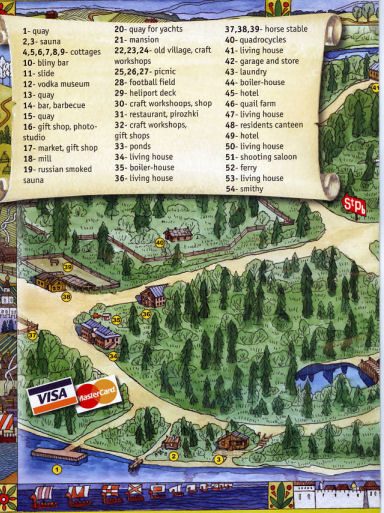 | 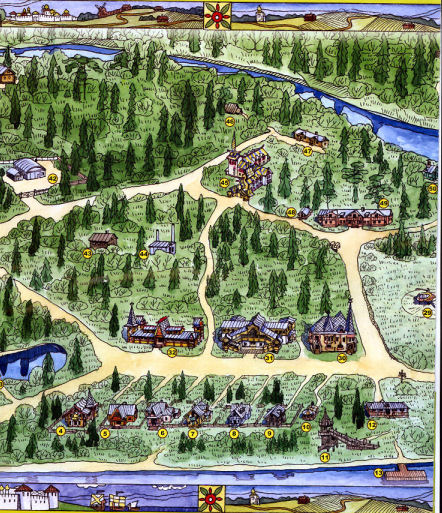 | |
The horses of Mandrogi did not appear to relish their life there. The ones in the large corral were forced to stand close together to avoid the water. It was rather sad. I asked the one that looked a little like Mr. Ed how the Russians treated him, but he was mum.
We turned the corner and headed back to the ship. It was warm out, and we were getting thirsty. We passed the captain strolling with a woman who was at least three or four inches taller than he. Needless to say, Tom and I engaged in mindless speculation about their relationship.
We passed two bath houses on the right. The brochure called them saunas, but the Russian term was banya (баня). It might have been interesting to try this, but we were totally unprepared, and at that point in the afternoon we were more interested in the prospect of inserting cold liquids into our bodies than in surrounding those same bodies with steaming vapors.
A rather large pond on the left offered the prospect of a nice secluded place to spend a few restful hours, but we had other plans.The restaurant just past the pond had one of the most unusual designs that I had ever seen. It had a ground level entrance that was flanked by ornate wooden staircases leading to a balcony on the second floor. The overall effect was quite inviting. If we thought that they might be serving beer, we might have entered.
The last distraction before the bar was the Vodka Museum. We might have gone inside if the admission had been free, but a young lady was obviously selling tickets at the counter. We saved our rubles for beer. The next building was the “bar,” which in most parts of Europe meant any eating or drinking establishment in which you walk up to a counter to place your order. This one had two sets of taps that appeared to serve up a good variety of beer on tap. However, when we tried to order, the lady behind the bar said that the dark beer was a German one called Kriek, and the light beer was a Russian one known as Nevskoe.[3] Evidently the other spigots were not functional. Tom splurged on a mug of the dark for two-hundred fifty rubles. I settled for the Russian beer for one-hundred fifty. It was ordinary, but that was fine with me. I seriously doubted, however, that Tom thought that his beer was worth more than $8.The bar was completely empty when we got there. I guess that this was to be expected. The Russian tourists were on Mandrogi with their families. The big drinkers on ships like ours probably signed up for the unlimited drinks package, so they would probably wait to get back to the ship where the booze was free.
Two very large gentlemen came in shortly after we got our beers and took a seat. They each had a shot of vodka and a beer, and they made very short work of them. Another fellow who was even larger than they were came in by himself. I could not determine what he drank.Tom and I read the small brochure about Mandrogi that had been given to us. It amazed us that they had this printed and distributed without paying someone who spoke English to read it over. How else could one explain sentences like “In the village of handicraftsmen the skilled workmen of folk trades not only create the works of art themselves but also instruct the uneasy (and often forgotten) intricacies all the comers.”?
When Tom and I had finished our beers, we decided to head back to the ship. We ran into Patti, who informed us that Sue had decided at the last minute to visit the fairy tale island. Oh, boy. Sue was notoriously bad with time, and I worried that she might get involved with something while adventuring on her own. However, she made it to the ship with time to spare.Mandrogi was nothing if not relaxing. The quiet rustic setting was a very pleasant contrast to the hubbub and elegance of St. Petersburg. The only really disconcerting thing about it was the treatment of the animals. Perhaps the Russians were a little behind in their sensitivity to this issue. If the methods used in food production in the U.S. are at least as disgusting, we Yankees are at least savvy enough not to let foreigners see them.
It occurred to me that I would almost certainly have been rather disappointed with Mandrogi if we had been traveling in the other direction – from Moscow to St. Petersburg. Because we were exhausted from our three days in St. Petersburg, we probably appreciated Mandrogi a lot more than if we had spent the previous three days on the ship.
On the ship I spent the rest of the afternoon working on my journal. I noticed lots of swimmers in the River Svir.The ship passed through what I think was the second lock of the voyage. Moscow was one-hundred fifty meters higher than St. Petersburg, so most of the locks elevated the ship.
Just before supper Konstantin gave a briefing in the Sky Bar about our next port-of-call, which would be Kizhi Island on Lake Onega. He told us that the beautiful wooden cathedral there was constructed with no nails. He also warned us to stay on the boardwalks because there were poisonous vipers on the island. Saturday’s supper would feature Russian cuisine.For supper I tried the shrimp cocktail, vegetable bouillon, and the cod. I considered all three to be mediocre. The shrimp was especially disappointing; they seemed to me to be totally tasteless. The other choices were salad mimosa, spinach soup, and leg of lamb with gravy.
I recorded no notes whatever about doing anything after supper.
[1] A good idea! A salmonella outbreak occurred in the U.S. while we were in Russia, and it was traced to eggs.
[2] My actual intentions, of course, were, as always, simply to create a journalistic work that accurately and comprehensively reflected an American tourist’s encounter with twenty-first century Russian customs.
[3] Невское is brewed in Russia, but the company is owned by the Carlsberg Group. The word just refers to the Neva River, just like Alexander Nevsky’s name. The ending reflects the fact that the Russian word for beer (пиво) is neuter.
